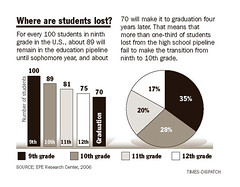High school dropout
The Baltimore Sun editorialized about Baltimore schools in the Friday paper, "No magic bullet," specifically about how the schools the State of Maryland took over are showing declines in student outcomes and this hardly justifies the State's plans to take over more schools. From the editorial:
Arguments for privatizing government functions often raise legitimate and practical issues - expediency, economic savings, a higher degree of professionalism. But privatizing public schools is nothing more than an act of desperation. It's the step taken after all other efforts have failed. Is it based on a flawed premise, that money and outsider expertise can solve the problems hounding some of our poorest schools?
I disagree with the point that privatization is "the step taken after all other efforts have failed." Most efforts to improve the schools, fail to address all the issues that are involved, from the administrative side, the teacher side, and the student and parent side.
There have been a few articles over the past few days that caught my attention. The Richmond Times-Dispatch (and others) have reported on the Southern Regional Education Board's program High Schools That Work. The RTD's article, "Reducing the perils of ninth grade:
Educators are stressing efforts to make sure students have the skills to succeed in high school," is about the SREB annual conference on the program. From the article:
"As we ratchet up high school graduation requirements, an awful lot of students leaving grade eight are not prepared for that rigorous kind of study," said Gene Bottoms, director of the Southern Regional Education Board's "High Schools That Work" program. ...Nationally, about 35 percent of students who drop out of high school never reach the 10th grade, Education Week reported last month. It said that for Virginia, the percentage dropping out in ninth grade was higher: 40.5 percent.
So many ninth-graders have to repeat their freshman year that they create what education analysts call the ninth-grade bulge. ... "The chances of completing high school are less than 50 percent for students who fail the ninth grade," Bottoms said. "It means you are no longer with your peer group. At that age, that is a powerful force."

Some past writings on this topic include:
-- Another lament about education
-- Other places to learn from, when thinking about DC public school closures
-- Thinking about schools
-- Charleston's "First Day Festival" promotes commitment to and involvement in education
-- Involving the community in school improvement
-- A thought or two on public assets and public schools
Index Keywords: education



0 Comments:
Post a Comment
<< Home